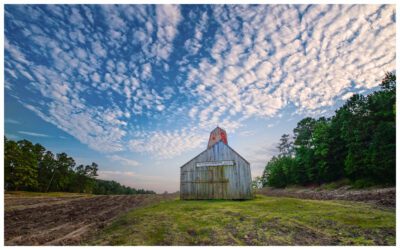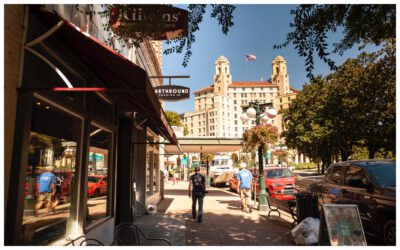[title subtitle=”words: Whitney Ray
images: courtesy Spooked documentary team”][/title]
Almost every night in Ottawa County, Oklahoma, on a country road littered with beer cans and fast food wrappers, a strange light appears. What it is and where it’s from have been widely disputed for more than a century. Written reports of the light date back to the 1880s. Some claim it was born out of the misery and death of the Trail of Tears, which ran through the area. Others say it’s a signal from another dimension, and another contingent says it’s the spirit of a mountain man looking for his lost love.
Whatever the origin, scientists and even the US Army have been unable to put the mystery to rest. What is known is its name, or actually its two names: locals call it either the Hornet Spook Light, after a nearby town that no longer exists, or the Joplin Spook Light because of its proximity to the Southwest Missouri city.
There are stories of the light chasing animals, frightening children and even killing unnamed travelers who were making their way through the western edge of the Ozarks. Though no deaths have ever been officially linked to the phenomenon, its legend grows. Almost every night, dozens of cars park along a half mile stretch of the wide dirt road where the light is most commonly spotted. Searchers bring binoculars, video cameras, and anything else that will help them get a closer look at the light.
They watch the light, which might appear for three minutes and then disappear for half an hour. And in its absence they talk amongst themselves. “Some weird stories have been told that it’s a headless ghost carrying a lantern,” said Missouri resident Chase Barnard.
Philip Freeman brought his rifle affixed with a powerful scope to get a closer look. He shares a story he heard, but could never verify. “This elderly couple was traveling down the road and this light came through their pickup — they had a pickup with a camper on the back — it went all the way through and she had a heart attack.” He added his own similar tale. “Close to thirty years ago, we were driving around in a pickup with the kids in the back and the thing kind of came at us and it split. It was two different colors when it split and everybody was all scared.”
Philip told his story to documentary film students from the University of Arkansas who set out to solve the mystery. They came away with as many explanations for its existence as there were members of their investigative team. On one outing the crew captured the light floating in and out of trees about a mile down the road. In their film Spooked you can see the light swell like a paper towel laid on a wet countertop. It pulses red and burns orange as it grows. In a matter of seconds the light turns yellow and stretches as thin as a sheet of notebook paper, barely visible to onlookers. It disappears. Then moments later reappears. The light shimmers, never holding steady. Then it’s gone again. The road is pitch black and all you hear are gasps, crickets, and the sound of rocks crunching beneath boots and sneakers.
The light seems miles away one moment and just beyond your reach the next. Some walk or drive toward the light, but are never able to catch it. Others claim it floats right up to them, or in a few rare cases shoots through their bodies.
Brian Petty, a former news photographer and award-winning documentary filmmaker, has heard them all. He coproduced and directed Spooked. Brian spent several weekends videotaping the light, conducting experiments and talking to folks along the dirt road. He took on the project hoping to solve the mystery. “I love to debunk things and I wanted to find a cause for it.” The documentary filmmaker has a bachelor’s degree in geology and a master’s degree in journalism from the University of Arkansas. His education led him to explore the geography of the land as a source of the light. Brian thinks underground caverns full of water that is slightly acidic and highly ionized could work like a car battery to create the light. “Over time, water in the underground caves can build up an electric charge and shoot light sporadically through the limestone layers that make up the land along the Oklahoma-Missouri border,” Brian explained. But this answer alone doesn’t satisfy him. Once he started investigating, he realized solving the riddle of the decades-old light was not going to be that easy. “This one still has some mystery in it for me.”
As it does for most who’ve investigated it. During WWII, army troops from Camp Crowder near Neosho, Missouri, were training for combat communication. They had learned how to use light signals in war. In their off time, many of the troops made the short trip across the Oklahoma-Missouri border to get a glimpse of the spook light. The mystery engulfed the troops and soon the Army Corps of Engineers was enlisted to take a shot at explaining it. In 1946, the Corps ended its investigation without an answer. It issued a report calling the phenomenon a “mysterious light of unknown origin.”
In 1955, retired Army Captain Bob Loftin tried his hand at solving the mystery. Loftin teamed with an investigator from the Federal Bureau of Standards and explored the possibility of a section of Route 66 as the source of the light. In Quapaw, Oklahoma, about ten miles west of the dirt road where most of the sightings occur, a series of lights converge. There are traffic lights, railroad crossing lights, a red light atop the Quapaw city water tower, and headlights and taillights streaking east and west on Route 66. Loftin claimed all these lights seem to merge when viewed from the spook light sighting grounds. He said the effect was enhanced by humidity, giving the lights a ghostly shimmer. Loftin’s findings were published in a booklet called The Tri-State Spook Light and sold for a dollar a copy.
The explanation has merit, but only if you ignore the eyewitness accounts and written reports published in newspapers and books before Route 66 was completed in 1933. Loftin also fails to explain how the lights from ten miles away could approach a car, an animal or a person. Brian has an explanation. He thinks there are two spook lights: Loftin’s light, which stays in the distance and disappears when cars aren’t racing up and down Route 66, and a light yet to be explained. And he holds tight to his theory that the light is a naturally occurring curiosity beaming from underground caverns filled with electrically charged water, but admits, it’s never been proven.
Brian likes it that way. “The neat thing about this is it’s a true American living legend on the edge of the Ozarks and you can go there and sit on the road and giggle and laugh and be with friends and somebody might get scared. It’s something you can actually see and it occurs every night and it’s fascinating.”
What’s great about the spook light is it’s there. Unlike aliens or the legendary Mexican monster chupacabra, the spook light makes itself available to all comers. The best time to look is between ten and midnight. Just bring your binoculars and your imagination.
Directions from Fayetteville to the spook light:
Take I-49 North for 60 miles. It will merge with Highway 71. Keep going north into Missouri. Once you enter Newton County, just before Neosho, start looking for the Iris Road exit. Go west on Iris Road until it dead ends at a T. Turn left on Stateline Road. You will be driving on the Oklahoma-Missouri border for a couple of miles until you see Ottawa County Road E 50. Turn right. Drive about 500 feet until you reach the start of the first dip in the road. Pull safely to the side of the road, turn off your lights and prepare to be spooked. Be respectful of the residents along the road. The sheriff’s office makes regular stops in this area to make sure people aren’t causing any problems.




